THE KODAK PAVILION
-
within its
free-form building, two theaters
-
with 70mm films
and many visual displays
|
Shadow-box "kiosks"
present Recordak features on rear-projected continuous slides,
using Eastman Carousel equipment in system.
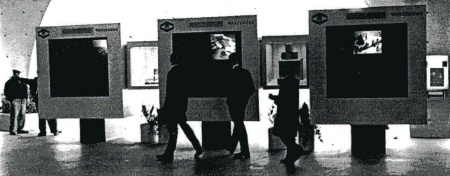 |
Slide projection installation
in kiosk showing modified Eastman Carousel projector with 450-watt
Cinemeccanica Xetron light beam.
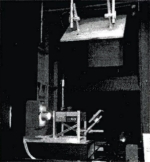 |
|
THE ARTISTRY of visualization
expected of a leader in photographic equipment and materials
has been achieved in the imaginative and exciting free-form building
of the Kodak Pavilion.
Picture-making opportunities abound on its "Moondeck"
roof; the world's largest outdoor color prints illuminate the
dominant "Picture Tower." Within, a pair of round theaters
each present excellent 70mm motion pictures.
|
Above: Kodak's "chimpanzee"
film projected in the "Instamatic" kiosk (at left)
is assured bright, sharp images by use of modified Eastman 16mm
arc mechanism with its Zeiss Xenosol II lamphouse and continuous
film loop. Long operating life, minimum care were objectives.
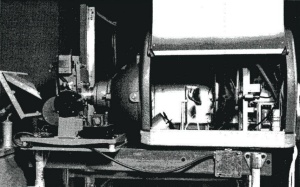 |
|
Dozens of small 'kiosks" around the exhibit areas offer
rear-projected slides and motion pictures on Kodak products and
a good part of the pavilion is devoted to examples of the best
in modern picture-taking; aerial photography, TIROS weather pictures,
and the like.
And throughout the Fairgrounds, Kodak signs point out good
picture possibilities, including correct exposures and even simple
prints for the camera fan!
Projection Engineering
Working closely with producers, architects, technical representatives
of Eastman Kodak Company and Eastman Chemical Products, Inc.
from earliest planning stages, Reevesound provided more than
two dozen motion picture technical systems for the Kodak Pavilion.
These include projection, sound and control devices located in
two theaters and in a number of individual displays strategically
located throughout the Pavilion.
Reevesound's projection, sound and control system in the Dome
Theater includes one Norelco 35/70mm projector operating at 70mm,
equipped with a 2500 watt Zeiss Xenosol II light source. A special
selsyn drive electrically interlocks the projector and a pre-programmed
60-channel sound system and a dimmer bank for synchronous operation
of theater lights.
|
|
As adapted by Reevesound, an Industrial Timer controller utilizes
sixty of eighty-two available channels, regulating thirty load
circuits. One foot of tape controls sixteen seconds of program
time. Interlock drive paces the tape as it controls faders, spots,
screen and cove light, a six-channel sound system, an atom model
and a Spitz star field projector, main feature of a thirteen-minute
film.
"The Searching Eye"
Shown daily in the circular Tower Theater, the 20-minute color
motion picture, The Searching Eye, is one of the focal
points of the Kodak Pavilion. Produced by Saul Bass, the film
dramatizes the heights of sensitivity to which vision may be
honed on a motion picture screen.
Reevesound's unusual motion picture system in the Tower Theatre
includes two 35/70mm Norelco projectors equipped with 2500 watt
Zeiss Xenosol II lighting sources, plus a multi-channel control
and audio system.
|
|
Visible all over the Fairgrounds,
the Kodak Picture Tower dominates the free-form Pavilion building
with its multitude of visual shows.
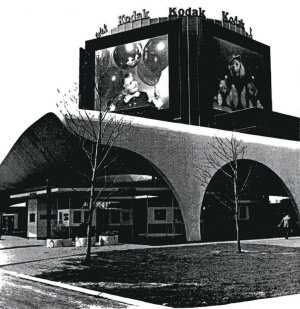 |
|
Reevesound's selsyn system electronically interlocks the two
Norelco projectors. One presents a 35mm film while its mate shows
a 70mm film. Screen images resulting from this interlock operation
of 35mm and 70mm projection give the film producer a dual format
capability which he needs to develop his theme and story.
This special system allows the two projectors to show alternate
segments of film. The 35mm machine opens the show, projecting
first-generation prints from original camera film. As the show
progresses, the 70-mm projector picks up the story, showing composite
prints all made from intermediates.
Transitions from one machine to another are timed with great
accuracy. Automatic
|
-
Tower Theater projection system
uses two 35/70mm Norelco projectors with 2,500-watt Xenosol arc
lamps and magnetic sound heads.
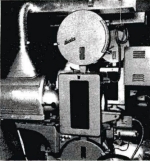 |
|
dowsers close to keep lamp heat off black leader on the machine
that is not in use. The dowser operations were programmed during
production of the film, and operate by control tones carried
on two of the magnetic stripes on the 35mm print.
Special Kodak/Reevesound motion picture systems are located
in ground-level kiosks at Eastman Kodak Pavilion, displaying
uses of photography in science. Systems include Eastman Model
25-B 16mm arc projector mechanism equipped with 1600 watt Zeiss
Xenosol II light source and 130-foot 16mm Reevesound synchronous
loop equipment.
First-surface mirrors mounted at front of projector mechanism
and above projection equipment re-direct light until it reaches
|
Source: BUSINESS
SCREEN MAGAZINE Presented courtesy Eric Paddon Collection
|
rear projection screen, where image is formed.
This special system for projecting a seven-minute sound motion
picture utilizes a Xenon light source and continuous film loop
for long operating life with minimum maintenance requirements.
An unusual Reevesound system in the Astronaut Bubble is designed
to activate an animated astronaut in sync with optical sound
track on 16mm film and motion picture display. The sound track
carries narration, as well as a subsonic signal to activate the
astronaut. The system includes a Reevesound-modified Eastman
25-B 16mm mechanism equipped with a 900-watt Xenon arc lamp.
Modified Industrial Timer controller
utilizes 60 of 82 available channels to control dimmer bank, 35/70mm
projector, six-channel sound system and other devices in the Dome
Theater.
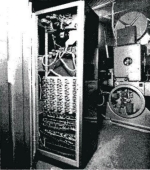 |
Lumitron dimmer bank atop six-channel
sound system activate fader, spots, screen, and cove lights in
Dome Theater. Both units are automatically controlled by Timer
shown a t left.
 |
|
At entrance to pavilion's Tower
Theater, this lighted panel proclaims "The Searching Eye"
70mm film feature, gives credits for production.
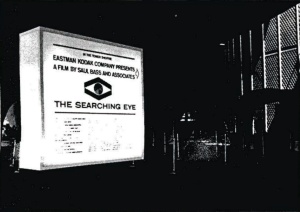 |
Below: one of comapny's many
well-trained "hosts" greets visitors at entrance to
Dome Theater where Eastman Chemical film is shown.
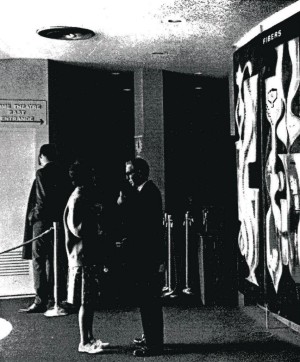 |
|
|